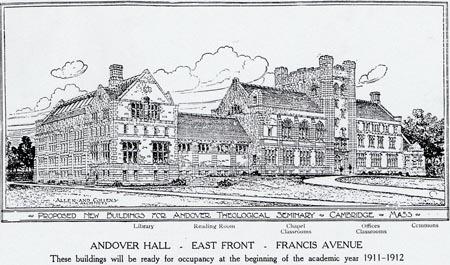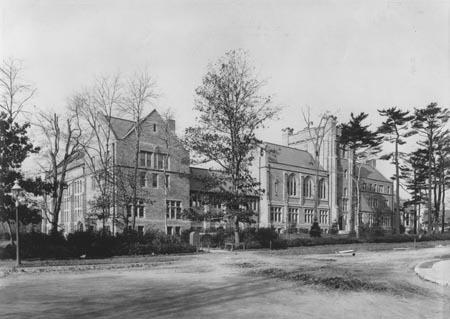Despite the alienation of a century earlier, bonds between the Andover Theological Seminary and the Harvard Divinity School had grown stronger through the years, and by 1906, when Andover felt a decline in attendance and a lack of resources, the Seminary entered into consultation with Harvard University about a possible affiliation and a plan of affiliation was agreed upon in 1908. The Seminary built Andover Hall, which was completed in 1911 at a cost of $300,000. It was designed by the firm of Allen and Collens, which specialized in ecclesiastical and neo-medieval designs. They also designed Riverside Church (1930) and The Cloisters (1938) in New York City. After the plan of affiliation was dissolved, Harvard bought Andover Hall in 1935.
When it was built, Andover Hall contained a library, lecture and seminar rooms, a chapel, professors' studies, administrative offices, and dormitory rooms. The style is called "Collegiate Gothic"; it is Harvard's only example of this style.
Address of President Fitch and Secretary Platner Andover Theological Seminary, Cambridge, Massachusetts:
Two years have passed since Andover Theological Seminary, after one hundred years of useful service on Andover Hill, was removed to Cambridge. In that time it has adjusted itself to its new surroundings, purchased a valuable tract of land, and laid the corner stone of its commodious and beautiful building, which it hopes to occupy by the autumn of 1911.
The experience of these two years and the present outlook have convinced those who are most intimately associated with the Seminary that the removal was wise, and that the prospects for increasing usefulness are most encouraging.
By the terms of affiliation agreed upon by the Trustees of the Seminary and the Corporation of Harvard University, the Trustees and Visitors retain entire control of the Seminary; they appoint and confirm the professors and administer all the trusts. The Seminary is to have its own chapel and lecture rooms, and conduct, so far as seems desirable its own religious services and social and religious organizations.
At the same time the relation established with the University grants to the Andover professors the opportunity of giving instruction to students enrolled in the Divinity School and other departments of the University, thus increasing the size and interest of their classes and enlarging the sphere of their influence. The Andover students also have the privilege of taking courses in the classes of Harvard professors, thus securing a variety and completeness of educational facilities which could never be provided in a country village.
By a mutually satisfactory arrangement, the libraries of the Seminary and the Divinity School are to be combined and placed in the Andover building. This will be a bond of union between the two schools and will provide one of the most complete theological libraries in the country.
The teachers and students of the Seminary have been cordially invited to share in the religious services and work of the University, and the churches and religious and charitable societies in Cambridge, Boston, and neighboring cities and towns offer many opportunities for Christian culture and Christian service.
President George Harris, D.D.LL.D., Amherst, President of the Board of Trustees
Albert Parker Fitch, D.D., President of Faculty
John Winthrop Platner, D.D., Secretary of the Faculty
Architectural sketch and address of Fitch and Platner from: Boston, a Guide Book, by Edwin M. Bacon. Boston: Ginn, special revised edition, Sept. 1910, prepared for the 14th session of the National Council of Congregational Churches. Boston: Ginn & Company, 1903.


